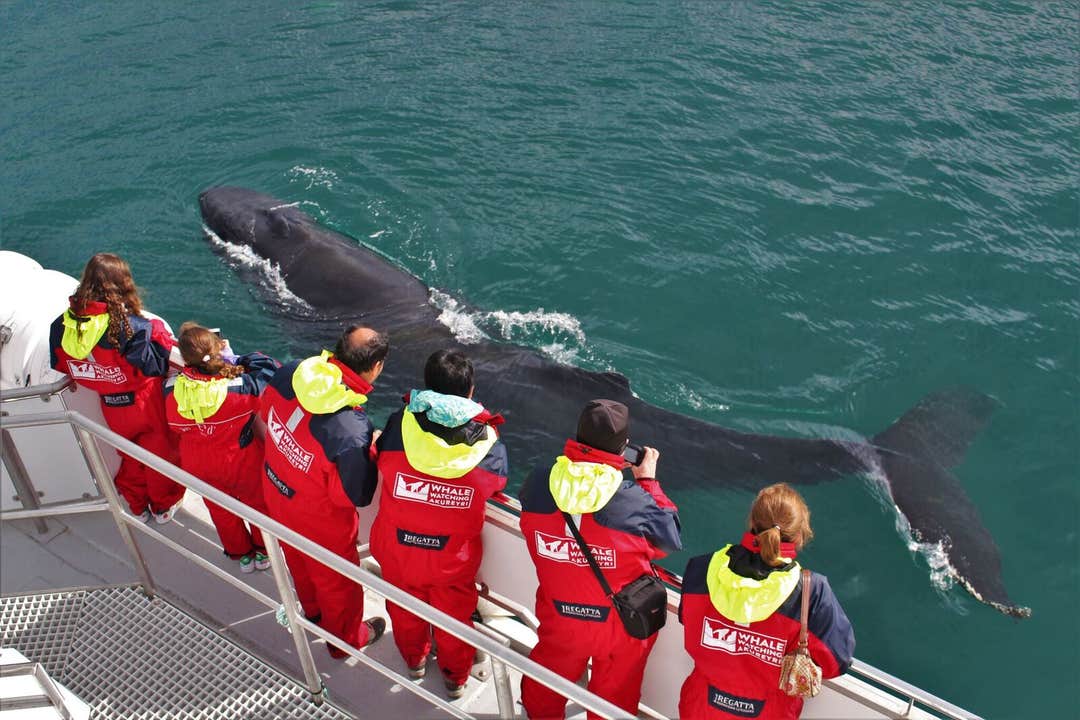Description
Résumé
Description
Partez observer les baleines depuis Akureyri, la capitale du nord de l'Islande, et découvrez la vie marine dans le fjord Eyjafjörður. Il s'agit d'une activité incontournable pour les amoureux de nature et de vie animale sauvage voyageant dans le nord de l'île !
L'excursion part de l'embarcadère flottant d'Akureyri, où vous pouvez vous faire déposer. Toutefois, il est relativement facile de marcher jusque-là, car ce n'est pas loin du centre-ville. Vous monterez à bord de votre bateau à grande vitesse. Il s'agit d'un navire élégant doté d'un grand espace intérieur, de plates-formes d'observation extérieures, d'un bar et d'une salle dédiée aux combinaisons — vous pourrez d'ailleurs emprunter ces combinaisons pour avoir bien chaud.
Une fois l'heure du départ arrivée, vous partirez dans le fjord à la recherche d'animaux sauvages. Vous commencerez votre excursion en regardant la belle ville d'Akureyri s'éloigner derrière vous et les montagnes de Tröllaskagi — la péninsule de Troll — se dessiner au-dessus de vous. Vous continuerez à naviguer jusqu'à atteindre les zones d'alimentation des baleines.
Les baleines à bosse sont l'espèce la plus communément observée dans le nord de l'Islande, surtout en été, bien qu'on les voie aussi en hiver. Ces acrobates grégaires sont souvent aperçues dans ces eaux. Elles divertissent les visiteurs en brisant la surface de l'eau, en plongeant et en se nourrissant.
Vous pourrez également avoir la chance de voir des dauphins à bec blanc en abondance tout au long de l'année, ainsi que des marsouins communs et même des phoques. D'autres espèces ont déjà été observées dans le fjord, comme la baleine bleue, l'orque et le rorqual commun. Néanmoins, ils ne résident pas en permanence dans la région et il est assez rare de les voir lors de nos excursions.
Si vous faites l'excursion en été, vous aurez peut-être la chance de voir des macareux moines qui se reproduisent en Islande durant cette saison, ainsi que d'innombrables autres oiseaux de mer. Si cette espèce en particulier disparaît en hiver, beaucoup d'autres subsistent.
Durant trois heures, vous naviguerez dans le plus long fjord glaciaire de toute l'Islande à bord de notre catamaran confortable et spécialement modifié, avec l'espoir d'apercevoir une baleine après l'autre. Il serait très rare de ne pas voir une seule baleine, un seul dauphin ou un seul marsouin au cours de votre excursion, car le taux de réussite de nos observations au cours des deux derniers étés est de 100 %. Toutefois, si c'est le cas, vous pourrez participer gratuitement à une autre excursion.
Et bien sûr, si l'excursion est annulée pour cause de mauvaise météo, vous pourrez participer à la prochaine excursion qui sera en accord avec votre emploi du temps.
Observez les baleines du nord de l'Islande au cours d'une expérience inoubliable. Vérifiez les disponibilités en choisissant une date.













